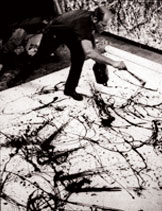The Art of Drip

It’s impossible, when talking about the techniques of drip or controlled pour painting, not to mention the influence of Jackson Pollock on the genre. His work is as controversial now as it was fifty years ago, yet whilst much is talked of the man and his paintings seldom is written about the actual process and techniques of drip painting or what an artist thinks about whilst he or she is engaged in their work. I will try and give you an insight into the technique from my own perspective, which is in no way linked to or copied from anyone else’s style or work.
How it all gets started
I lay a blank piece of canvas on the floor. At this point I know what colours I am using and the basic structure of what I want to produce. I can see very clearly what the finished article will look like. Right down to the sizes of the strokes, depth of colour, how many layers it will be composed of, how I’m going to thin the paints and in what order I will start. I spend a long time mixing colours and even longer on the thinning process, using a number of different thinning agents and in different ratios of paint to thinners. This affects how the painting will look when it dries.
Paints, tools and colours
Paints are normally oil based and enamel based glosses although I do use a number of different blacks in my paintings (including high gloss, semi-gloss and matt). There is something so final and cohesive about the use of black. I have been told that I shouldn’t need to use black but I strongly disagree. Using this contrast against every other colour offers a tremendously intense finality to my paintings and is quite often the last colour I introduce. I normally stick to five or six colours, two of which will always compliment each other plus a white and black. I seldom use brushes, preferring wooden spoons and nylon spatulas
Application – it’s all in the wrist
I use an array of wrist sweeps and movements both forwards and backwards in each stroke. This way I can control where the first wave of paint goes (typically 75% of the volume on the tool) and just as importantly apply the same principal on the way back with the remaining 25% of the paint. Sometimes this is in the same direction as the first and sometimes it is in a different one. This helps me get a double sweep for every single application of movement (gesture). I control the angle relative to the canvas, the sweep of the wrist, the height above the canvas (which varies greatly), volume of paint per gesture and where on the canvas the gesture is heading. I make decisions in a split second as to where the paint is to be placed relative to all the other paint on the canvas at that particular time. I normally work quickly when I’ve got a single colour to apply as I like to keep the motion constant. It is typical for me to take long periods of contemplation between colour applications as I have to visualize what the next wave of gestures will need to be, based on what has gone before. I mainly use an arc movement in my wrist to apply the paint but also use drops, throws, half-arcs and full circles. Once I have applied a layer of colour I choose whether to let it dry before applying the next or to carry on with the next colour depending on the effect I am trying to achieve.
The whole is greater than the sum of the parts
As the painting dries it changes. This is a very cool thing as the painting takes on an organic tone – it grows and morphs into a single mass as it develops. I often sit back and watch as complex neural pathways and junctions form as the paint cures. By carefully applying linear and balanced gestures I can create a complex layering of paint that forms interlacing sections that entice the viewer into the painting. Puddling, marbling, coagulation and rippling are ever present in my compositions, often only visible when you get up close and personal with the piece. I control everything and leave nothing to chance. I know where I am placing every stroke. It’s a relative cliché to suggest that the painting talks back to me but I have to succumb to such a statement as it’s true. I want to express the vibrancy and excitement of my technique in a way that connects to the viewer. Whether you see it as a whole or as a series of parts is irrelevant as long as you see it for what it is – a living, active and expressive creation of a collection of moments. Don’t place hidden meanings behind what you see, just let the painting wash over you.

